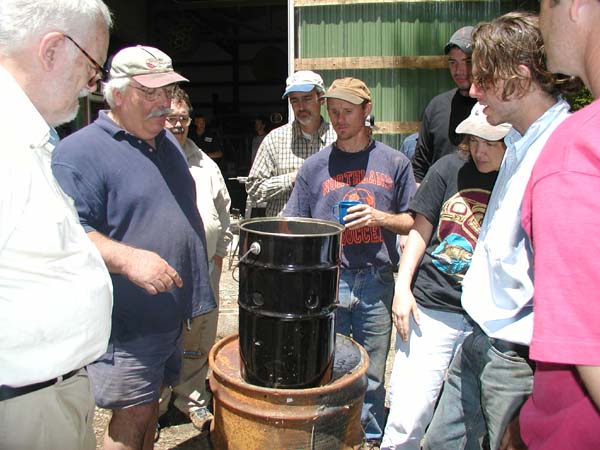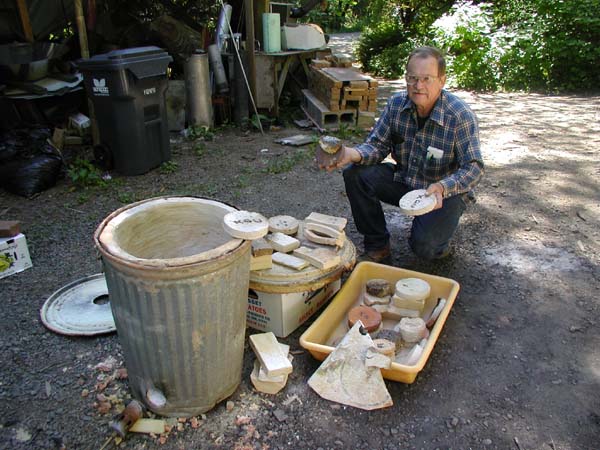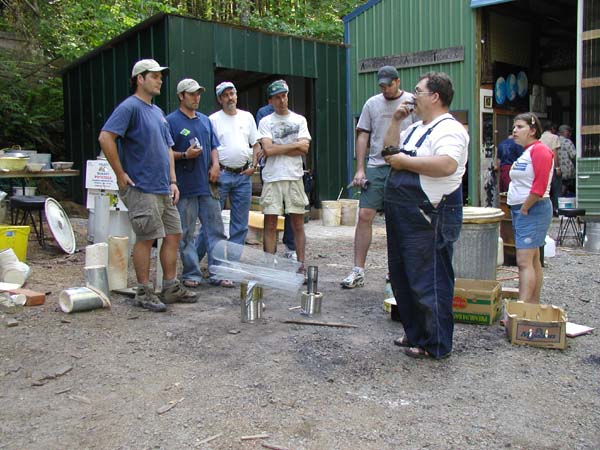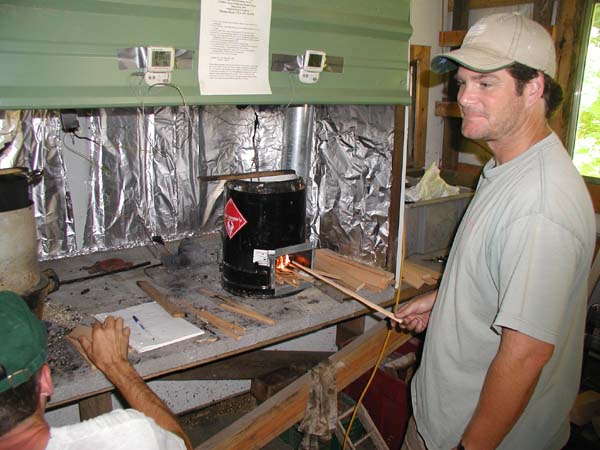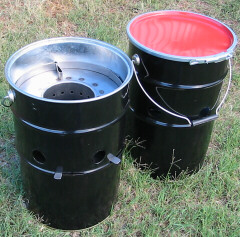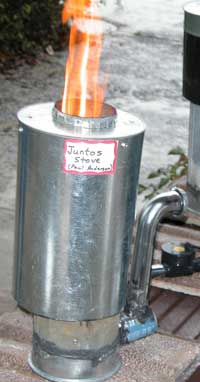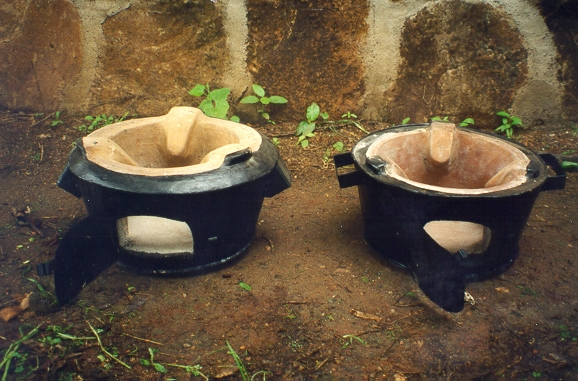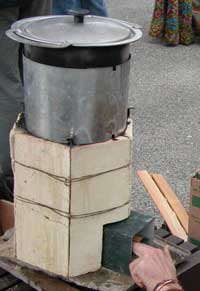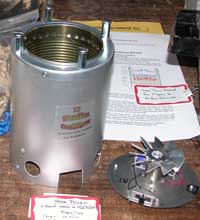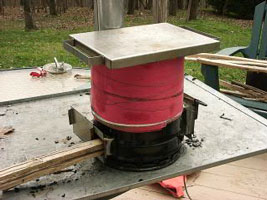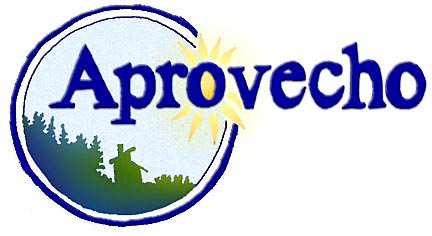 ETHOS Stove Testing and Design Seminar
ETHOS Stove Testing and Design Seminar
June 2 -6, 2003 Aprovecho Research Center, Cottage Grove, Oregon
Summary and Results from the Seminar, Dean Still (June 18, 2003)
Dr. Tami Bond, Ron Larson, Dr. Dale Andreatta, Dr. Larry Winiarski, and others shared a week at Aprovecho experimenting and addressing vernacular cooking stove topics. They looked at gasifying, charcoal making, stoves in detail. Simultaneously, cooking stoves, like the Rocket, that are designed to encourage initial 'complete' combustion were tested. Using an Enerac 3000 combustion analyzer, a HOBO CO sensor, eight thermocouples and equipment to do Water Boiling Tests, the group shared experiences intended to foster the development of better stoves for the needy.
Several topics of interest were:
1.) the role of preheated secondary air
2.) the effect of controlling primary air
3.) how a fan effects combustion
Format:
Readings and lectures and classes on evolution of stoves, refractory ceramics, sheet metal prototyping, pyrolysis. The first two days were testing. Then inventing new stoves, setting up experiments on stoves tested.
Dean Reports:
Larry Winiarski ran his 1960 Ford pick-up on wood gas, which had a few folks snapping pictures! We ran three tests each on the Vesto, Juntos, Turbo, Rocket, Lanny's, Ron's pyrolizers, open fire. We also got continuous CO readings in a enclosed room while using each stove.
One of the valuable lessons that the week taught us was how to improve the testing. Dale Andreatta and Tami Bond are helping us to get ready for the next seminar.
The sandwiches were great, coffee hot, weather lovely, Joe and Allen (ISU) (MU) danced with the prettiest girls in Eugene. I hope that Morgan and Jesse caught lots of fish on their way back to Colorado (CSU)! Rosalie (HSU) will be going with us to Honduras to learn how to commercially disseminate stoves.
Ron reports:
1. There were about 12-15 there - about half stove "veterans" and about half newcomers - a good mix - all very interested in stoves.
2. A majority there were most interested in and knowledgeable on the Rocket Stove. I was able to try some new tests with a charcoal-maker. Others helped to run tests on four other donated stoves - those from Tom Reed, Paul Anderson, Crispin, and Lanny Henson.
3. Two tests were run (and I assume Dean will give some reports later)
a) efficiency - a standard water load (5 liters) and a standard fuel supply (if appropriate) - 700 grams wood.
b) emissions - a CO test with 4 liters water and 400 grams wood Two HOBO CO meters at different heights in a fairly tight room (exchange time about 20 minutes. Also an older "smoke stack" unit (Enerec?) had been donated and was only partly useful - but gave CO2 and O2 as well as CO readings when higher than 0.1 % (not sufficiently sensitive for this meeting).
4. Most everyone alternately participated in the tests or in lectures/classes in the AM or PM. One day with Larry Winiarski on design principles (I missed this as I had quite a few stoves to test) ; another
day with Ken Goyer on insulative bricks. Other days were more flexible - people mostly doing what they wanted. I had an hour or so to talk about charcoal making. Tammy had to leave after end of day 2
5. Some new ideas for me to follow up on:
a) The placement of sawdust in a small can placed in the middle of the combustion area seemed to have pyrolyzed successfully with the pyrolysis gases helping out. I think doing this with sawdust (or leaves, etc) on the outside might be better - insulating as well as adding to the fuel supply and charcoal output. The radially directed heat can thereby be useful. The outer fuel supply option has not yet tested.
b) Use of a thin metal horizontal "windpumper" deflector "disk" between the pyrolysis and combustion regions to achieve a swirl (idea coming from Jess and Morgan of Colorado State) - looked quite good. Seems like it could have general applicability.
c) The balancing of a larger upper pyrolysis unit (coffee can) on the lower fuel chamber (also coffee can - but smaller diameter) worked well. Three screws could be on either the upper (pointed in) or lower can (pointed out). I think the former would be better (easier to load fuel) - but I only tried the latter. I had about (wasn't measured) a 7 mm gap between the cans - and believe it was much too large - based on measured low CO2 (3%), high O2(18%) readings obtained by Jess. In a test about 6-7 years ago they were about equal at 10-11 % - which I think is a good range. Earlier, the secondary air gap was much smaller (maybe 1-2 mm?), when the two cans were of the same diameter (and wired together) or the whole was of one piece of metal - with many small holes of 2-3 mm diameter. The Rocket had even smaller(larger) levels of CO2(O2) - which also indicated low temperatures at the pot due to excess air. I now feel it important to control secondary air - for this excess air reason.
d) Dean said he had some success in obtaining light output from slits in a metal combustion region. I am anxious to try the same - I am going to try a glass lantern "bowl" for the combustion region with a piece of 4" stove pipe for the fuel container (and possibly some additional heat capture - but with light and heat as the major purpose).
e) I was very impressed with the many types of insulative bricks that have been developed. For me, one of the easiest to work with is a brick that starts as 85% charcoal and 15% clay (final density about 50%). But also saw some nice bricks made from vermiculite and pumice.
f) It is very important that the operator be able to see the flames. I did a poor job at Approvecho (and is a problem with ceramics).
g) I need to work out a means of supporting the pot independently of the pyrolysis and combustion chambers (for safety reasons)
h) In a separate message, I will report on the various ceramic designs (none of which were too successful).
i) I need to become more familiar with the modeling program and results given by Dale Andreatta -
http://www.repp.org/discussiongroups/resources/stoves/Andreatta/Heatloss.htm . His analytical material needs to be expanded by others (Dale will be saying more about the test room, I believe).
6. My main conclusions on this meeting and this sort of meeting:
a). A major benefit is being able to talk over ideas with other researchers - both formally and informally. I hope Dean will plan another and that others will jump in as well.
b). It is very helpful to have a standardized format of testing - even if not perfect, and this type of meeting and testing should be replicated.
c). We still need to work out appropriate test procedures (such as monitoring CO2).
1) Results should not be reported (or should be carefully caveated) if the same amount of fuel cannot be consumed in the tests - or if the pots and stoves are not relatively well matched. Not all stoves are designed for the same jobs.
2) Foundations and government sources should support stove testing laboratories in much larger numbers.
3) We should start a new "stoves" thread on test procedures.
4) I pointed out my unhappiness with the way efficiency computations handled charcoal production (too complicated to explain here).
d). There is a lot to be gained from working closely with Universities on class and special projects.
Images From the Seminar Courtesy of Robert Winiarsky and Ken Goyer
OTHER LINKS TO STOVES TESTED
* Engineers in Technical Humanitarian Opportunities of Service
541 942-0302
 ETHOS Stove Testing and Design Seminar
ETHOS Stove Testing and Design Seminar  ETHOS Stove Testing and Design Seminar
ETHOS Stove Testing and Design Seminar 